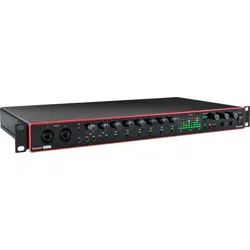Loading ...
Loading ...
Loading ...

20
speakers to other pairs of Line Outputs (e.g., near-fields to Line Outputs 3 and 4, mid-fields to Line
Outputs 5 and 6) and switch between them in Focusrite Control. Scarlett 18i20’s ALT function (see
below) has been included to make using a second pair of monitors very simple.
IMPORTANT:
LINE OUTPUTS 1 to 4 incorporate “anti-thump” circuitry that protects your speakers if the
Scarlett 18i20 is turned on while the speakers (and amplifier if used) are connected and
active.
LINE OUTPUTS 5 to 10 do not have this circuitry. If you’re using additional speakers
connected to these outputs, we recommend that you first power your Scarlett 18i20 on, then
turn on the speakers or power amplifier.
But get into the habit of following this general rule in any case - it is always good audio
practice to turn on a speaker system of any kind after turning on the equipment feeding it.
NOTE: You run the risk of creating an audio feedback loop if loudspeakers are active at the same time
as a microphone! We recommend that you always turn off (or turn down) monitoring loudspeakers
while recording, and use headphones when overdubbing.
Speaker Switching
The 18i20’s Speaker Switching function makes adding a second pair of monitors very easy: simply
connect the second pair to the ALT outputs – LINE OUTPUTS 3 and 4. After enabling Speaker
Switching in Focusrite Control, you can then switch between your main monitors and the secondary
pair either by pressing the front panel ALT button, or by clicking on the corresponding on-screen
button in Focusrite Control. When ALT is active, the main mix output will be fed to the ALT outputs
instead of the MAIN, and the green ALT LED will light to confirm this.
In the example below, we have shown passive speakers with a separate power amplifier as the main
monitors and active speakers as the secondary pair, but of course, any type of monitors you prefer
may be used in either case.
Main
Monitors
(Passive)
Secondary
Monitors
(Active)
ALTMAIN
Loading ...
Loading ...
Loading ...
